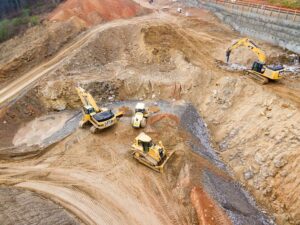Kentucky Construction Logistics: Excavate, Engineer, Deliver On Time
Effective construction site logistics transforms excavation and civil engineering endeavors into streamlined operations that meet deadlines, control costs, and maintain safety. In Kentucky’s variable terrain and regulatory landscape, poorly organized site planning can stall a project for weeks and inflate budgets. This article outlines the principles of site logistics, excavation planning, civil works coordination, material handling optimization, safety integration, technology adoption, and localized challenges. Readers will discover how each segment—from utility coordination to GPS tracking—interconnects under a unified logistics framework that boosts productivity and positions Earth Works, LLC as the trusted partner for civil projects across Kentucky.
What is Construction Site Logistics and Why is it Critical for Kentucky Projects?
Construction site logistics encompasses the strategic planning, scheduling, and coordination of resources, equipment, and personnel to ensure that each project milestone is met efficiently. In Kentucky’s construction environment, logistics management must account for seasonal weather variations, regulatory compliance, and supply chain constraints. By mapping workflows, allocating storage zones, and synchronizing deliveries, site logistics reduces idle time and mitigates on-site congestion.
Locally calibrated logistics create measurable benefits for general contractors and civil works managers. Organized material staging and equipment mobilization directly translate into predictable timelines and tighter cost control. These efficiencies not only safeguard project profitability but also enhance on-site safety by minimizing vehicle movements and pedestrian interactions, laying the foundation for advanced excavation and civil works planning.
How Does Construction Site Logistics Improve Project Timelines and Efficiency?
Construction site logistics accelerates project timelines by sequencing tasks to eliminate bottlenecks, which optimizes machinery utilization and workforce deployment. When material arrivals are synchronized with excavation phases, crews spend less time waiting and more time advancing foundational work. This streamlined approach reduces downtime between site preparation, trenching, and backfill operations.
- Enhanced equipment turnover through just-in-time mobilization that minimizes idle heavy plant.
- Coordinated supply chain schedules that prevent stock-outs of critical aggregates and piping.
- Real-time monitoring of material flows to adjust sequencing and avoid work stoppages.
These improvements reinforce on-site productivity and directly support the rapid completion of excavation and civil engineering milestones.
What Are the Main Components of Construction Site Logistics?
A comprehensive logistics strategy hinges on distinct components that interact to support safe and efficient operations. Understanding each element’s role clarifies how they collectively drive project success.
Each component is interdependent, and optimizing their relationships prepares the ground for rigorous excavation site logistics planning.
How Does Earth Works, LLC Deliver Expert Construction Logistics in Kentucky?
Earth Works, LLC applies decades of combined experience in excavation and civil works to implement customized logistics plans throughout Kentucky. Leveraging best practices in material handling and site planning, the team develops detailed layouts that account for topography, regulatory setbacks, and utility corridors. By integrating GPS tracking for fleet management and digital scheduling tools, Earth Works, LLC minimizes unplanned downtime and maintains transparent communication with general contractors.
Through kyearthworks.com, prospective clients can explore tailored excavation logistics offerings that align with local codes and environmental guidelines. This structured approach delivers measurable improvements in project timelines, cost control, and safety metrics, making Earth Works, LLC the partner of choice for complex civil engineering projects across the state.
How to Plan Excavation Site Logistics for Large-Scale Civil Works in Kentucky?
Planning excavation site logistics involves a systematic assessment of existing conditions, resource allocation, and material flow paths before breaking ground. A thorough pre-excavation survey identifies subsurface utilities, soil composition, and drainage patterns, which informs the layout of access roads and spoil zones. By mapping these factors, project managers can develop a logistics blueprint that anticipates challenges unique to Kentucky’s clay soils and seasonal rainfall.
Once the site assessment is complete, detailed schedules for heavy equipment mobilization and spoil removal ensure that each phase flows seamlessly into the next. This phased planning minimizes overlap between site clearing, trench excavation, and structural backfill, cutting transit times for machinery and aggregate deliveries. Incorporating contingency buffers for weather-related delays further strengthens the overall logistics plan, setting up civil works operations for consistent progress and on-time completion.
What Are the Steps in Pre-Excavation Site Assessment and Preparation?
Pre-excavation site assessment defines the logistical framework by evaluating terrain, existing infrastructure, and environmental constraints. A survey team identifies underground utilities and marks no-dig zones, while soil tests determine excavation methods and spoil classifications. These insights feed into a detailed site plan that allocates haul routes, storage areas, and equipment staging points.
This preparation phase reduces unforeseen excavator repositioning and mitigates utility strikes. By integrating geotechnical data into the logistics map, project managers can forecast handling requirements—ensuring that spoil removal, dewatering, and shoring operations proceed without costly interruptions.
How is Heavy Equipment Mobilized and Demobilized Efficiently?
Efficient mobilization sequences heavy machinery based on project phases, starting with clearing and grading equipment and transitioning to excavators, loaders, and compactors as trench work commences. Transport routes are pre-approved to avoid residential zones and comply with Kentucky weight restrictions.
Key steps include:
- Pre-scheduling delivery windows aligned with site access plans.
- Designating off-peak haul times to reduce traffic conflicts.
- Coordinating demobilization in reverse order to clear areas for follow-on trades.
This disciplined approach ensures that plant movements do not impede on-site workflows and contribute to safe, uninterrupted progress.
What Are Best Practices for Spoil Removal and Material Flow Management?
Managing spoil removal and material flow demands clear staging areas and efficient hauler rotations. Establishing separate zones for recyclable aggregates, hazardous soils, and general spoil streamlines disposal processes and enforces regulatory compliance. Effective haul road design and routing prevent material spills on public roads while shortening cycle times.
These practices maintain site cleanliness, accelerate turnover of excavation phases, and support civil works activities by ensuring that required backfill material is readily available when needed.
What Are the Best Civil Engineering Site Planning and Coordination Strategies?
Civil engineering site planning integrates logistical oversight with technical design to synchronize infrastructure installation, earthworks, and access management. By developing a master coordination schedule, project teams can sequence utility work, roadway construction, and structural foundations to avoid conflicts between adjacent trades. This integrated approach prevents unplanned rework and preserves contiguous progress across multiple civil scopes.
Embedding site security and temporary access controls into the logistics blueprint enhances both safety and productivity. Controlled entry points and monitored traffic routes safeguard personnel and equipment while enabling smooth material deliveries. These strategies reinforce a cohesive environment where civil works, excavation operations, and support services advance in concert.
How to Coordinate Utility Installation and Infrastructure Projects?
Coordinating utility installation requires mapping existing services and liaising with utility providers early in the design phase. By slotting electrical, water, and sewer lines into a phased logistics plan, contractors can conduct trenching, backfill, and reinstatement activities with minimal disruption to other trades. Regular communication with municipal inspectors and utility owners ensures that inspections and approvals align with construction milestones.
This coordination reduces idle equipment time and minimizes potential clashes between utility crews and heavy plant operations.
What Are Effective Road, Access, and Site Security Management Techniques?
Developing defined haul routes and gate controls elevates site security and optimizes traffic flow. Temporary access roads hard-surfaced with crushed stone prevent bogging of heavy vehicles, while controlled entry checkpoints monitor personnel and material movements. Security fencing around sensitive infrastructure areas protects equipment and discourages unauthorized entry.
These measures maintain uninterrupted logistics flows and reinforce safety protocols by directing vehicles away from pedestrian zones.
How Does Project Site Coordination Enhance Safety and Productivity?
Project site coordination aligns logistics with safety management by reducing on-site congestion and limiting interactions between moving machinery and work crews. Clear demarcation of storage zones and haul roads separates pedestrian paths from heavy plant routes, lowering the risk of accidents. By embedding coordination checkpoints into the project schedule, Earth Works, LLC ensures that inspections, material deliveries, and equipment turnovers occur in planned sequences, fostering a secure and efficient work environment.
How to Optimize Heavy Equipment Material Handling on Construction Sites?
Optimizing on-site material handling involves designing storage layouts, implementing inventory tracking, and coordinating distribution pathways. Well-planned stockpile locations near work fronts reduce handling distances and enable rapid material retrieval. Digital inventory systems linked to GPS tracking alert managers when supplies fall below threshold levels, prompting timely reorders.
Streamlined handling processes improve safety by minimizing manual lifts and preventing material overstocking. When materials move through defined corridors and bypass active excavation zones, crews maintain momentum and project schedules remain intact.
What Are Best Practices for On-Site Storage and Inventory Management?
Effective on-site storage utilizes marked areas for different material types, preventing cross-contamination and simplifying access. Palletized storage for fittings and pipe segments keeps inventory organized, while bulk materials such as sand and gravel reside in lined containment zones to control runoff.
- Implementing barcoded inventories for real-time stock counts.
- Rotating stockpile usage to minimize material degradation.
- Establishing clear signage and access protocols.
These measures foster orderly material distribution and support consistent workflow progression.
How to Manage On-Site Movement and Distribution of Materials Safely?
Safe distribution of materials requires designated delivery corridors that avoid active excavation zones and pedestrian pathways. Coordinated timing of deliveries ensures that forklift, crane, and telehandler operations do not collide with heavy equipment.
Strict adherence to these parameters minimizes incidents and promotes a controlled logistics environment.
What Specialized Handling is Required for Large or Hazardous Components?
Large components such as precast concrete panels or hazardous materials demand bespoke handling plans. For oversized elements, route clearance and load certification ensure safe transit from laydown areas to installation points. Hazardous soils and chemical tanks require sealed containment and licensed transport according to state regulations.
These specialized protocols preserve site safety and compliance, underpinning sustainable excavation and civil engineering operations.
How Does Construction Site Safety and Compliance Integrate with Logistics?
Safety and compliance are inseparable from site logistics because effective material and equipment flows reduce accident risks and regulatory violations. Risk assessments identify interaction points between heavy plant and personnel, enabling mitigation measures such as exclusion zones and temporary works design. Embedding safety checklists into logistics planning ensures that each movement of machinery and material aligns with site health and safety requirements.
Regulatory compliance—including environmental controls and traffic management—relies on a clear logistics framework to implement permits, signage, and monitoring. When safety is integrated into every logistical decision, projects maintain seamless progress while safeguarding crews and neighboring communities.
What Are Key Risk Assessment and Mitigation Strategies for Site Logistics?
Risk assessments for logistics map high-traffic intersections and lifting activities to designate exclusion zones. Control measures such as physical barriers, warning signage, and spotter roles prevent collisions and equipment-related incidents. Incorporating regular toolbox talks on logistics hazards educates crews and fosters a safety-first culture.
Implementing these strategies reduces near-miss occurrences and supports efficient site operations by clarifying safe movement protocols.
How to Implement Temporary Works and Traffic Management Plans?
Temporary works—such as shoring and propping—must be sequenced within the logistics plan to align with excavation phases. Traffic management plans designate public road diversions, on-site haul routes, and pedestrian crossings, ensuring that deliveries and workforce access occur safely.
Key elements include:
- Installing temporary road signage and barriers.
- Scheduling peak-hour deliveries outside school and commuter times.
- Coordinating with local authorities for traffic permits.
These controls integrate logistics with safety obligations and public convenience.
What Local and National Regulations Affect Construction Site Logistics in Kentucky?
Kentucky construction logistics must comply with state environmental regulations on soil erosion, stormwater runoff, and aggregate storage. Federal Occupational Safety and Health Administration (OSHA) standards dictate equipment operation, fall protection, and hazard communication. Understanding these requirements informs logistics layouts, material handling protocols, and temporary traffic controls, ensuring that each phase meets statutory obligations.
How Does Technology Enhance Construction Site Logistics Management?
Technology transforms site logistics by providing real-time visibility into equipment movements, material stocks, and workforce allocation. GPS tracking systems relay live locations of excavators, haul trucks, and generators, enabling managers to reroute assets swiftly when delays arise. Digital planning tools—such as BIM and 4D scheduling software—visualize logistics sequences and detect clashes before ground is broken.
These digital innovations support predictive retrieval of information, empowering teams to optimize site layouts and resource flows based on current project metrics rather than static plans.
What Role Does GPS Tracking Play in Equipment and Material Monitoring?
GPS tracking equips project managers with precise insights into machinery locations, utilization rates, and idle periods. By analyzing these metrics, logistics coordinators can adjust deployment schedules to maximize plant productivity. Real-time alerts for out-of-zone movements also enhance security and reduce unauthorized usage.
These capabilities strengthen equipment accountability and underpin agile resource allocation on busy excavation and civil works sites.
How Do Digital Planning Tools Improve Site Coordination and Efficiency?
Digital planning platforms consolidate design models, construction schedules, and logistics maps into an integrated interface. BIM-driven logistics simulations reveal spatial conflicts between material laydown areas and work cell zones. 4D sequencing aligns excavation activities with concrete pours and backfill operations, minimizing overlaps and rework.
This synergy between design and logistics accelerates project delivery and bolsters collaboration among engineers, contractors, and site teams.
What Are the Benefits of Real-Time Supply Chain and Logistics Monitoring?
Real-time supply chain monitoring reduces material shortages by flagging low stock levels and triggering replenishment workflows. Live dashboards provide visibility into delivery ETA and on-site consumption rates, enabling just-in-time ordering that shrinks storage footprints. Immediate insight into logistics performance enhances decision-making and mitigates risks of work stoppages.
What Are Common Questions About Construction Site Logistics?
Industry professionals often seek clarity on core logistics concepts, from plan structures to cost-control principles. Addressing these queries builds topical authority and prepares project teams to implement robust site logistics frameworks.
What is a Construction Logistics Plan (CLP) and Why Is It Important?
A Construction Logistics Plan (CLP) is a documented roadmap that outlines site access, delivery schedules, storage layouts, and traffic management measures. It is important because it anticipates operational constraints, ensures regulatory compliance, and communicates logistics requirements to all stakeholders. A well-crafted CLP prevents site congestion, reduces safety risks, and supports timely project completion by aligning every movement on-site with overarching objectives.
What Are the 4 Types of Logistics in Construction?
Construction logistics can be categorized into four types: procurement logistics for sourcing materials; inbound logistics for deliveries to site; on-site logistics for storage and distribution; and outbound logistics for waste removal and deliveries off-site. Each category addresses distinct challenges—supply reliability, site coordination, material flow, and disposal compliance—to form a cohesive logistics strategy that sustains efficient operations.
What Are the 5 R’s of Logistics in Construction?
The five R’s of construction logistics are the right materials, right quantity, right condition, right place, and right time. Adhering to these principles ensures that materials arrive undamaged, in sufficient quantities, at designated locations, and exactly when crews need them. This framework minimizes delays, cuts waste, and maintains consistent work progress across excavation and civil engineering tasks.
How Can Construction Site Logistics Reduce Costs and Improve Safety?
Construction site logistics reduce costs by optimizing equipment utilization, eliminating idle time, and minimizing material handling distances. Safety improves as clear traffic routes, defined storage zones, and controlled equipment movements lower collision risks. Together, these efficiencies preserve budgets and protect personnel by ensuring that logistics workflows prioritize both economic and safety outcomes.
How to Address Kentucky-Specific Challenges in Construction Logistics?
Kentucky’s clay-rich soils and variable weather patterns require adaptive logistics that account for ground stability and seasonal access constraints. Implementing robust drainage controls and all-weather haul roads prevents equipment bogging and maintains supply chain continuity. Collaborating with local suppliers reduces transit distances and aligns deliveries with state permitting windows, ensuring that logistics plans remain resilient under regional conditions.
Construction site logistics form the backbone of successful excavation and civil engineering projects across Kentucky. By integrating detailed planning, advanced technology, and regulatory compliance into a unified framework, project teams achieve predictable timelines, controlled budgets, and enhanced safety. Earth Works, LLC stands ready to deliver tailored logistics solutions that address local challenges, optimize resource flows, and drive project excellence through every phase of site development.


